People travel to the remotest parts of the world to discover beauty, explore nature and to satiate their wanderlust desires. Whether it is the snow peaked mountains of Switzerland, the abundant wildlife of South Africa, the winding lanes of Paris, the stunning beaches of Australia or Miami, the sky is the limit for those looking to unravel the wonders of the world. One such place, which is the perfect amalgamation of peace, purity and natural beauty is our very own neighbour, this piece of heaven tucked into the womb of the Himalayas, the tiny nation of Bhutan.
For such a tiny country, Bhutan is home to dramatic landscapes ranging from rolling green plains to steep valleys, isolated mountain peaks soaring above the world to bustling traditional markets. For most of us who live in cities, visiting Bhutan is like putting our fast-paced lives on pause. This land is immersive, not necessarily because of its allurements, but because of the sheer simplicity of its surroundings and its people. Nestled in the lap of the Himalayas, Bhutan offers you peace for your mind, beauty for your eyes and purity for your soul.
Here are some of the key places to visit over a week to 10 days holiday in Bhutan:
Thimphu: The capital city of Bhutan, Thimphu is a perfect example of modernization in the face of staying true to the roots of one’s culture. Here you will find some of the most sumptuous restaurants, nightclubs, shopping malls and quaint monuments like the Chari Monasteries, Buddha Dordenma, National Memorial Chorten, Semtokha Dzong and the Tashichho Dzong. It is the home of Bhutan’s royal family, colourful authentic Farmer’s markets and the majestic Druk Wangyal Lhakhang. The most charming thing about Thimphu in my opinion is that this city has zero traffic lights, instead, you will find police officers stationed at major intersections, manually directing the traffic! As someone who comes from one of the most crowded cities in the world, this is simply a refreshing break from the constant struggle of traffic intersections and honking!
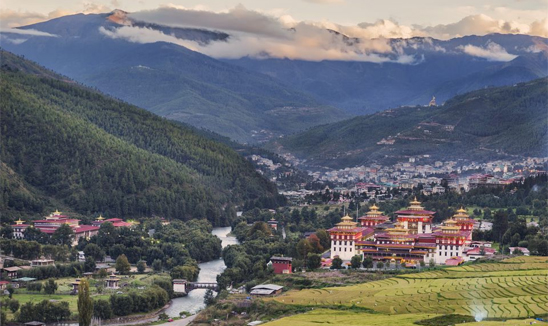
Paro: If you intend to fly into Bhutan, this picturesque valley town will be your first glimpse of the country, for here lies Bhutan’s only international airport. Standing 2,250 meters above the sea level, Paro is home to beautiful meadows, fortresses, religious sites and monasteries. An experience worth having here is the opportunity to live in a traditional albeit well equipped Bhutanese Farmhouse - a simple mud-and-stone house built without nails amidst rolling green fields. Other places worth paying a visit are the ruins of Drugyel Dzong, one of Bhutan’s oldest temples Kyichu Lhakhang, the national museum Paro Ta-Dzong, and Kila Goenpa.
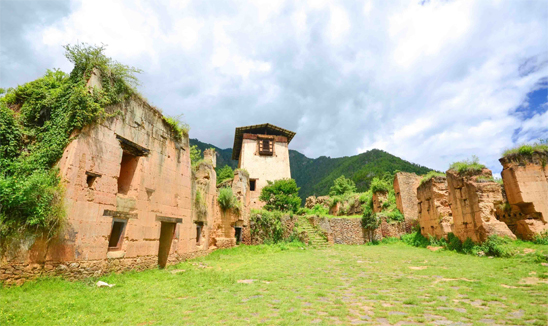
Punakha: The Himalayan town Punakha was once the capital of the Wangchuk kings and it surely still radiates an old world charm. Located right at the spot of confluence of the holy Mo and Pho Chhu rivers, the Punakha Dzong is not only an important historical and spiritual monument, but is also blessed with striking natural beauty. Punakha is also a haven for shopaholics with its traditional markets while also having a number of hiking trails in the vicinity. But the best way to experience the vibrancy of Bhutan is through the Punakha Festival. Held in the honour of Guru Padmasambhawa, this festival brings to light the Bhutanese culture. The celebrations comprise of traditional Bhutanese masquerade dances with elaborate masks. These dances are performed by monks clad in elaborate colorful robes who chant sacred Buddhist scripts while reenacting valiant battle scenes of the Bhutanese victory over Tibet to the echo of a thousand of spectators. It is a door into their world, a door wide open with dance and revelry, and an excellent peak into what this nation offers.
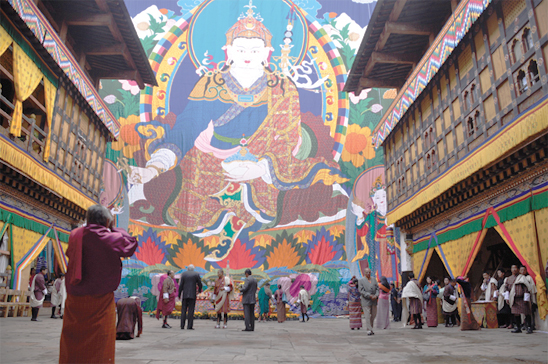
Chimi Lhakhang: On a little hillock in the Punakha village lies the beautiful temple of Chimi Lhakhang - the county’s most visited and most cherished shrine. With its gigantic prayer wheels, golden roof and the statue of Guru Padmasambhava, this shrine pays homage to the most divine aspects of the Bhutanese culture. The reason for it being the most visited temple of the nation is because it is widely lauded to be the Temple of Fertility and visited by childless couples as well as couples who wish to bless their young children by warding off the evil eye. The most striking aspect of this temple is the intricately designed phalluses displayed over multiple walls of the temple to drive away bad omens and boost fertility of the visiting families.
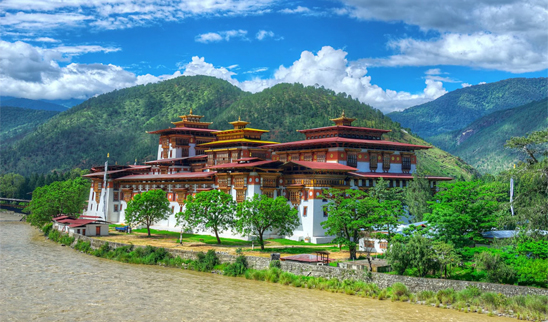
Phobjikha Valley: How blissful do you reckon would the happiest part of the happiest place in the world be? Well, you will have to visit Phobjikha valley to experience this for yourself - a river of pearl-white glacial water running against stark black mountains. Located on the border of the Jigme Singye Wangchuck National Park, the valley is majestic enough to satiate any lover of nature, bird watching and adventure, with endless grassy meadows, multiple hiking trails and an abundance of wildlife including wild boars, leopards, foxes, the Himalayan black bear and the Himalayan Serow.
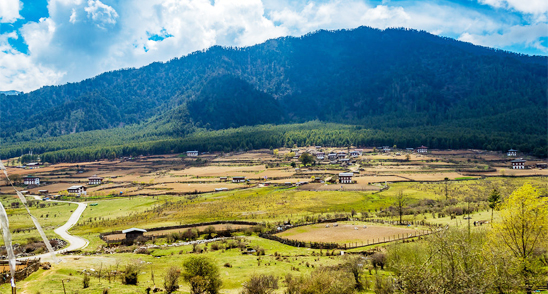
Zuri Dzong Hike: While on the topic of hiking, another must-visit spot for hikers is the arduous yet incredibly rewarding trek to Zuri Dzong. Considered to be the place where Lord Buddha himself meditated during his time in Bhutan, this 14th century fortress offers a breathtaking view of the Paro Valley. The fortress itself is a fine specimen of Bhutanese architecture, with high double walls and a five-storey building housing the Dzong dedicated to the protector of the valley, the Zaa.
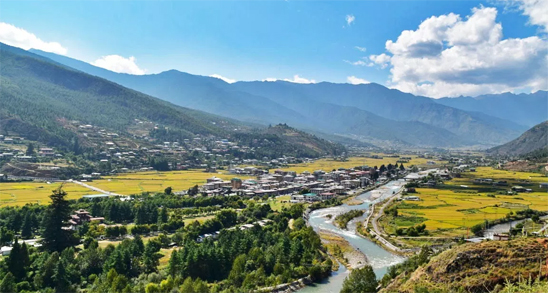
Trongsa: In the very heart of Bhutan lies the quaint little town of Trongsa, nestled between mountain ranges on both sides, with stunning views of the surrounding valleys. Key attractions in Trongsa include the Trongsa Dzong - easily visible from pretty much anywhere in the city, the Thruepang Palace, Kuenga Rabten - the wonderfully preserved winter palace of the 2nd king of Bhutan and the Chendebji Chorten - the 18th century pure white temple pattered on Kathmandu’s Swayambhunath Stupa.
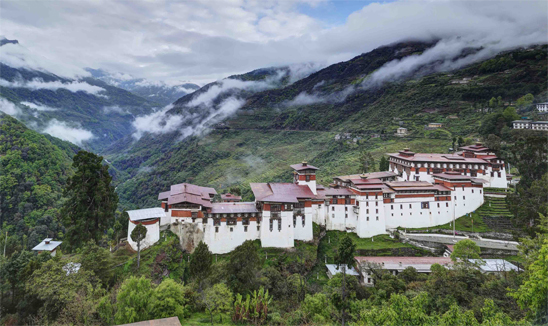
Buddha Dordenma Statue: This 51.5-meter-tall gold-gilded statue of Lord Buddha stands on top of a hill in the Kuenselphodrang Nature Park overlooking the southern entrance to the Thimpu valley. Not only this statue one of the largest statues of Lord Buddha in the world, the statute itself is ensconced with 125,000 thousand smaller statues of Lord Buddha! Legend says that this massive edifice was built in order to fulfil a prophecy to bring an era of peace and happiness to the world.
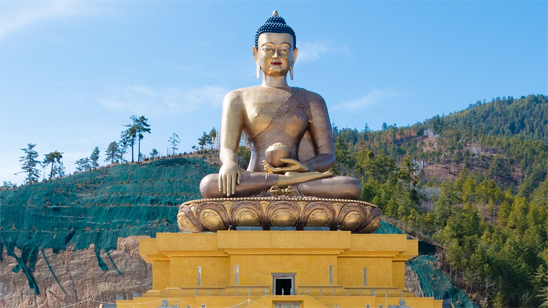
Tiger’s Nest Monastery: As per Bhutanese legend, Guru Padmasambhava flew to the very spot that hosts this monastery on a tigress’s back to battle with a demon that was harming its people. While there are no flying tigresses here now, the Monastery sits on the edge of a cliff with nothing but deep blue pine forests below. The monastery is one of the most sacred sites for Buddhists all over the world, and its sanctity is something that will remain in your heart, long after you have left those blue pine forests.
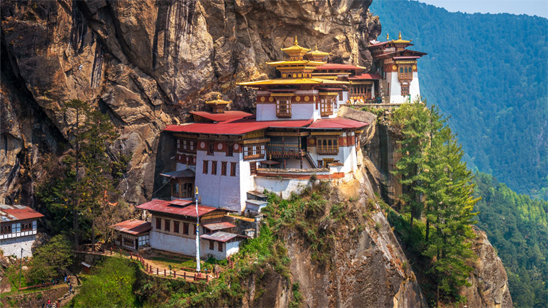
How do I go to Bhutan?
Getting to Bhutan from any major city in India is a fairly easy. Drukair and Bhutan Airlines have round the year flights from Kolkata and Delhi to Paro - the country’s international airport. These two airlines also have seasonal direct flights from Mumbai to Paro.
For those who do not want to take the air route, you can take an earthlier (and cheaper) route by train. The nearest railway station is Jaigaon, a town on the Indo-Bhutan border, with a direct train to Hasimara, mere 17 kilometers away. There are also direct trains to Hasimara from Kolkata, Delhi, Ranchi and Kanpur. If you are travelling on a tight budget, taking a train is an excellent option, the journey will be a treat for the eyes and a blessing on the wallet!
If you wish to boast of a cross-country road trip, you can travel directly from Jaigaon, or opt for private cabs that take you directly into the heart of Bhutan.
Do I need a visa?
Short answer - No.
The immigration office in Phuentsholing (the border town) issues travel permits for members of the SAARC nations. You merely need to verify key documents (Identification proof, travel itinerary, hotel bookings, photographs etc.) to secure a travel permit. For those flying in, an on-arrival travel permit shall be given directly during immigration at Paro International airport.
What else should I know about Bhutan?
Bhutan is probably home to the friendliest people in the world. Especially for Indians, language should not be much of a barrier. Although the official language of the country is Dzongkha, most citizens speak fluent English, and a few older citizens are even fluent in reading and writing Hindi! But it wouldn’t hurt to learn a few catchphrases in Dzongkha.
The official currency of the country is Ngultrum, which is more or less equal to INR in terms of denomination. To add icing to the cake, barring the new INR 2,000 and 500 notes, all minor rupee currency notes are freely acceptable in Bhutan.
What Bhutan doesn’t have an abundance of, is ATM machines. It is best to stock up on your cash when in Thimpu and other major towns. The best time to visit is in the autumn months from September to November, when the weather is just about perfect, the nature is in full bloom and there are no rains to hamper your time in paradise.
For adventure and hiking enthusiasts, the temperatures can dip significantly on peaks, and thus it is best to carry suitable heat-preserving hiking gear and winter wear.
How to I plan a holiday in Bhutan?
Starting this September, Odyssey Tours and Travels has multiple trips planned exclusively to Bhutan (some even covering exciting parts of Burma), ranging from week long trips to longer vacations lasting over ten days. The packages differ based on what you seek from your holiday – highlights of the country, leisure, a thorough cultural exploration or the best of both nations – Bhutan and Myanmar. What is best about this offering is that each aspect of your trip can be customized to suit your requirements. Our only goal is to ensure that you have the best time of your life exploring this blessed, beautiful land, as mysterious as it is mystifying.
Bhutan has been time and again named the Happiest place on Earth, and why this nation rightly deserves this title can be understood only after being here. Happiness here is not quantified, it can be felt in the very air, in the smile of its people, in the purity of its environment. It is a paradise in the most literal sense, because the mind is free of worry, away from monotony and its ties, soaring high, just like its many mountain peaks!
Leaving a chance to explore this country is like doing a disservice to oneself, and this autumn is the best chance to have the purest, happiest holiday of your life!